Danganronpa: Trigger Happy Havoc
Trigger Happy Havoc

Name
| Kanji | ダンガンロンパ 希望の学園と絶望の高校生 |
| Romaji | Dangan Ronpa: Kibō no Gakuen to Zetsubō no Kōkōsei |
| English | Dangan Ronpa: Academy of Hope and High School Students of Despair |

Danganronpa: Trigger Happy Havoc is a Japanese visual novel game developed by Spike (Later known as Spike Chunsoft). It is the original main title in the Danganronpa series.
statistics
development notes
Writer: Kazutaka Kodaka
Artist: Rui Komatsuzaki
Producer: Yuichiro Saito
Composer: Masafumi Takada
Developer: Spike (PSP), Spike Chunsoft (post-2012), Abstraction Games (PC)
Publisher: JP- Spike (PSP), Worldwide- Spike Chunsoft (post-2012), English: NIS America (Vita/PS4; Former)
Platform(s): PSP, iOS, Android, PS Vita, Microsoft Windows, OS X, Linux, PS4, PS5, Nintendo Switch, Xbox One, Xbox Series S/X, Windows 10.
release dates
PSP:
- Japan- Nov 25, 2010
- Japan- Oct 10, 2013
- Taiwan- Jan 13, 2014
- Hong Kong- Jan 16, 2014
- United States- Feb 11, 2014
- Canada- Feb 11, 2014
- Europe- Feb 14, 2014
- Australia- Feb 14, 2014
- United States- Mar 14, 2017
- Canada- Mar 14, 2017
- Europe- Mar 17, 2017
- Australia- Mar 31, 2017
- Japan- May 18, 2017
- Worldwide- Feb 18, 2016
- Japan- Aug 20, 2012
- Worldwide- May 21, 2020
- Worldwide- Dec 3, 2021
- Worldwide- Jan 18, 2022 Xbox Game Pass:
- Worldwide- Jan 18, 2022
- Worldwide- Jan 18, 2022 PC Game Pass:
- Worldwide- Jan 18, 2022
rating
Japan: Cero- D
North America: ESRB- Mature 17+
Europe: Pegi- 16
Taiwan: GSRR- 18+
Australia: M
release notes
It was originally released in Japan on November 25th, 2010 for the PlayStation Portable. A promotional demo called ''Dangan Ronpa: Kibō no Gakuen to Zetsubō no Kōkōsei (Trial Version) was released a month before on October 10th. Following this were iOS and Android versions released in Japan in August 2012. The game was later re-released on October 10th, 2013 as part of Danganronpa 1.2 Reload, a compilation for the PlayStation Vita containing this game and Danganronpa 2: Goodbye Despair. In addition to improved graphics, each game was also given additional content. NIS America localized and released this Vita version standalone in February 2014 in North America and Europe. A port for Windows was released on February 18th, 2016 and a PlayStation 4 version of 1.2 Reload was released in March 2017 as well. This PS4 release would be the last one from NIS America, as Spike Chunsoft would take over English publishing of all Danganronpa games in the 2020s.[1] NIS America delisted their digital Vita version on September 4, 2020 due to this decision.[2]
An "Anniversary Edition" was launched for Android and iOS devices worldwide on May 21st, 2020 as part of the Danganronpa 10th Anniversary celebration. This "Anniversary"-branded version would also be released on the Nintendo Switch as a physical-only bundle for Danganronpa Decadence and individually in the Nintendo e-Shop in late 2021. On January 18th, 2022, this version was released for Xbox One, Xbox Series S & X and Windows 10 as a digital only download as well as Microsoft's gaming subscription: Xbox Game Pass & PC Game Pass.
Contents
Summary
"Hope's Peak Academy is home to Japan's best and brightest high school students — the beacons of hope for the future. But that hope suddenly dies when Makoto Naegi and his classmates find themselves imprisoned in the school, cut off from the outside world and subject to the whims of a strange, murderous little bear named Monokuma. He pits the students against each other, promising freedom to anyone who can murder a fellow classmate and get away with it. It's up to you to find out who Monokuma really is, and why you've been taken from the world you once knew. But be careful what you wish for — sometimes there's nothing more deadly than the truth..."
- Official synopsis
Gameplay
In Danganronpa: Trigger Happy Havoc, the player controls Makoto Naegi, a student at Hope's Peak who is forced into a killing game with other students. Each chapter is divided into two parts: School Life, in which the player can explore the academy and progress through the story, and the Class Trial, in which the player must deduce the culprit of a murder.
 A screenshot of a conversation with Sayaka Maizono.
A screenshot of a conversation with Sayaka Maizono.During School Life, the player can explore the school grounds in a first-person perspective. In certain locations, the player moves a crosshair cursor to converse with other characters and interact with various objects. Examining specific objects yields the player Monocoins, which can be redeemed for presents from The All-Mighty Monomono Machine located in the school's store. As the game progresses, more areas in the academy become available, along with places that were sealed off in the previous chapter(s) on accessible floors.
School Life is separated into two sections: "Daily Life" and "Deadly Life". In "Daily Life," the players converse with other characters and progress through the story. When speaking with other characters, some comments can be "reacted" to to reveal new information. Daily Life also features "Free Time" segments, where the player can spend time with other characters and give them presents, which in turn reveals more information about them and unlocks "skills," which aid the player in certain aspects of the Class Trial, and "skill points," which determine the number of skills that can be used.
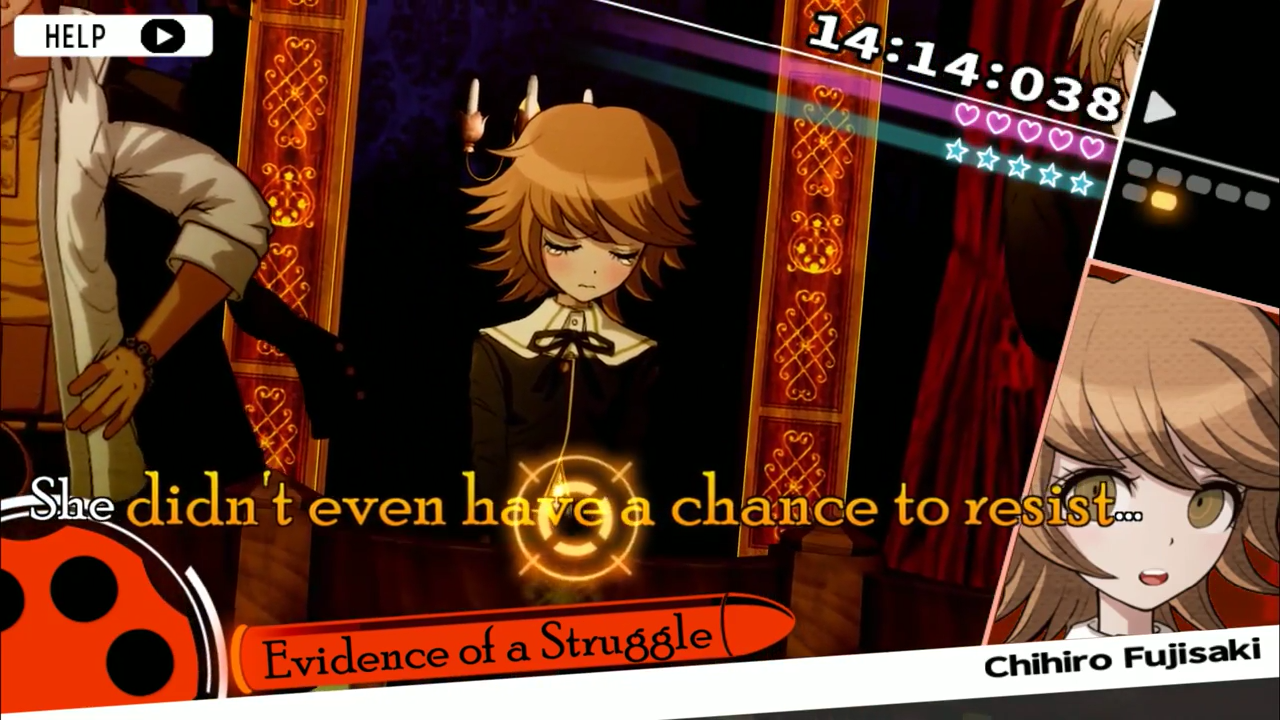 Nonstop Debate.
Nonstop Debate.Once a murder has occurred, the game transitions into Deadly Life, where the player must look for clues throughout the academy. Evidence and testimonies, or "Truth Bullets," are stored in the player's e-Handbook. After all possible Truth Bullets are found, the game shifts to the Class Trial.
In a Class Trial, the students must discuss among themselves who the killer is. The game’s logic difficulty will determine how the facts are shown and how logical they are (the logic difficulty can be changed in the settings at almost anytime). The Class Trial consists of four main game modes: Nonstop Debate, Hangman's Gambit, Bullet Time Battle, and Closing Argument. The most common of these is the Nonstop Debate, in which characters will discuss their thoughts on the case. During these sections, the player is armed with "Truth Bullets," metaphorical bullets containing evidence relevant to the case. To break the debate, the player must find a lie or contradiction among the "weak points" (words highlighted in yellow) in the characters' arguments and shoot them with the correct truth bullet. In Hangman's Gambit, the player must shoot specific letters to spell out a clue. Bullet Time Battle is a one-on-one debate against another student featuring rhythm-style gameplay. As the opponent makes remarks, the player must press buttons in time to the beat to lock onto the remarks and shoot them down. To close out the case, "Closing Argument" is a puzzle in which the player pieces together a comic strip depicting how the murder went down.
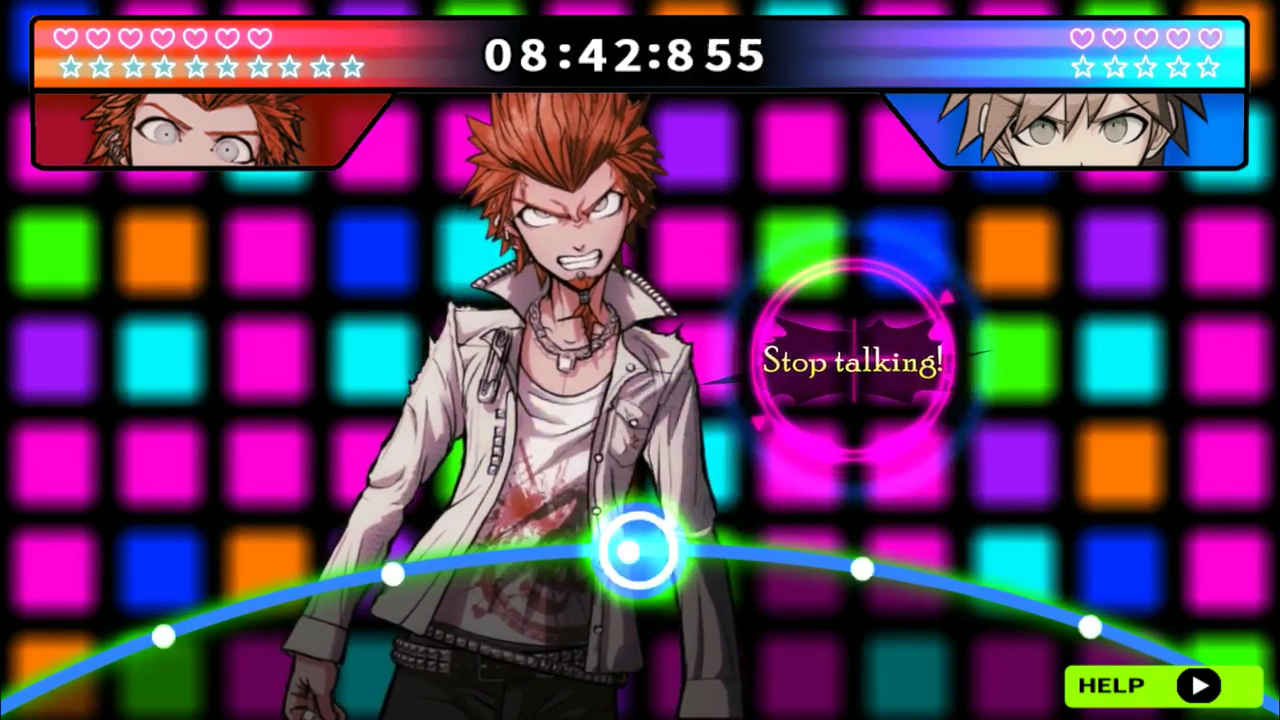 Bullet Time Battle.
Bullet Time Battle.Occasionally, the player must answer a multiple-choice question and present a shred of evidence to progress through the Class Trial. The player's "Influence" among the other students is represented by hearts, which are reduced whenever the player makes errors in shooting contradictions or presenting evidence and are slightly replenished once the player does otherwise. The game ends if the player loses all their "Influence" or runs out of time during a segment. At the end of a trial, the game ranks the player's performance and rewards them with Monocoins.
When the player completes a chapter, a screen with outlines of every student's silhouette appears. Text at the top of the screen displays "Surviving Students"; though moments later, the casualties' sprite colours change to show their status change from alive to deceased as the number on the bottom changes accordingly to the number of surviving students.
Development
DISTRUST was a visual novel devised by writer-director Kazutaka Kodaka. The general premise was "15 teenagers killing time or our 7 days survival war" (15少年少女殺戮期 もしくはボクらの7日間生存戦争), and was co-developed by Kodaka alongside Spike Chunsoft (then Spike) producer Yoshinori Terasawa and character designer Rui Komatsuzaki between 2007 and 2009. The game featured realistic blood in a gritty, industrial, post-apocalyptic environment inside the school building, and a subdued colour palette. During development, it was determined that the gruesome aesthetic of this prototype, along with the small market share of the niche PlayStation Portable console, made the game potentially unmarketable and the game's development was ultimately scrapped. Despite the cancellation, the game was reworked by the team into what later became Danganronpa: Trigger Happy Havoc, which shares many similarities with it's cancelled predecessor, with many character names, designs, and the overall premise of the story being carried forward.
Reception
Critical Reception
Danganronpa: Trigger Happy Havoc Has received favourable reviews in Japanese game media and was awarded a pre-release rating of 36/40 by Famitsu.[19] The English localization of the game has earned a Metacritic review aggregate score of 80 for the PS Vita release[20] and a score of 82 for the PC port,[21] indicating generally favourable reviews.
The English adaptation won several awards, including Game Informer's "Best Vita Exclusive of 2014" and "Best Adventure of 2014",[22] RPGFan's "Best Story of 2014"[23] and "Best Graphic Adventure of 2014",[24] Hardcore Gamer's "Best New Character of 2014" (Monokuma)[25] and the Metro's #14 in their "Top 20 Games of 2014".[26]
Review Scores
Review scores for the original PS Vita release in English on February 11, 2014.
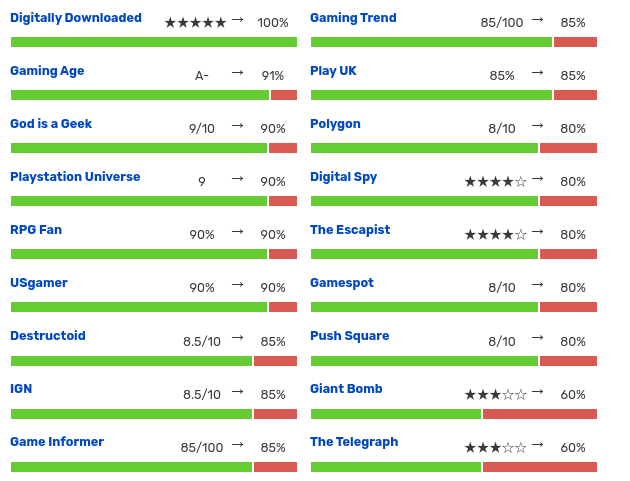
Sales
It was released to PSP on November 25, 2010, and on August 20, 2012, it was later made available for iOS and Android OS in Japan. The game was released on January 13, 2014, in Taiwan, February 11, 2014, in North America, and Europe and Australia on February 14, 2014. It sold 25,564 copies in Japan in its first week, debuting in 8th place in the weekly game sales charts,[27] and three months of sales sold over 85,000 copies.[28]
Anime
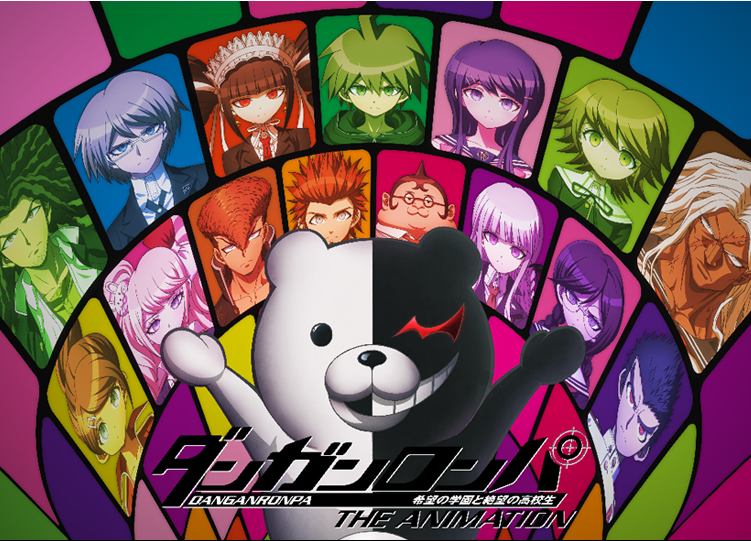 The anime's cover.
The anime's cover.Danganronpa: The Animation (ダンガンロンパ: The Animation) was a faithful but abridged 13-episode adaptation of Danganronpa: Trigger Happy Havoc produced by animation studio Lerche, which featured the original Japanese voice cast of the game returning to voice their characters. The series debuted on July 4, 2013, and was simulcast with English subtitles by Funimation on their streaming platform. Later, fully translated dubbed versions of the series were released in English by Funimation on November 9, 2015, and in German by FilmConfect from August 26, 2016. The series has also been subtitled in German, French, Italian, and Spanish.
Because the adaptation was subtitled by Funimation at the same time as the game was being translated by NIS America, both the English subbed and dubbed versions of the anime have a separate canon from the game in terms of certain terminology, most notably character talents being literally translated as "Super High School Level" rather than "Ultimate", and character names such as Mondo Owada being romanized as Mondo Ohwada. Despite criticism from some fans for its diversion from the games, the localisation style was maintained in the anime series' 2016 sequel, Danganronpa 3: The End of Hope's Peak High School, for consistency reasons.
Manga

|
Danganronpa: Kibō no Gakuen to Zetsubō no
Kōkōsei (Trial Version) A 1 volume manga adaptation of Dangan Ronpa: Kibō no Gakuen to Zetsubō no Kōkōsei (Trial Version), which features an alternative version of Chapter 1 than that which features in the full game. The manga was released in Japan on October 10, 2010, as a preorder bonus for those who pre-ordered Danganronpa: Trigger Happy Havoc from TSUTAYA. |
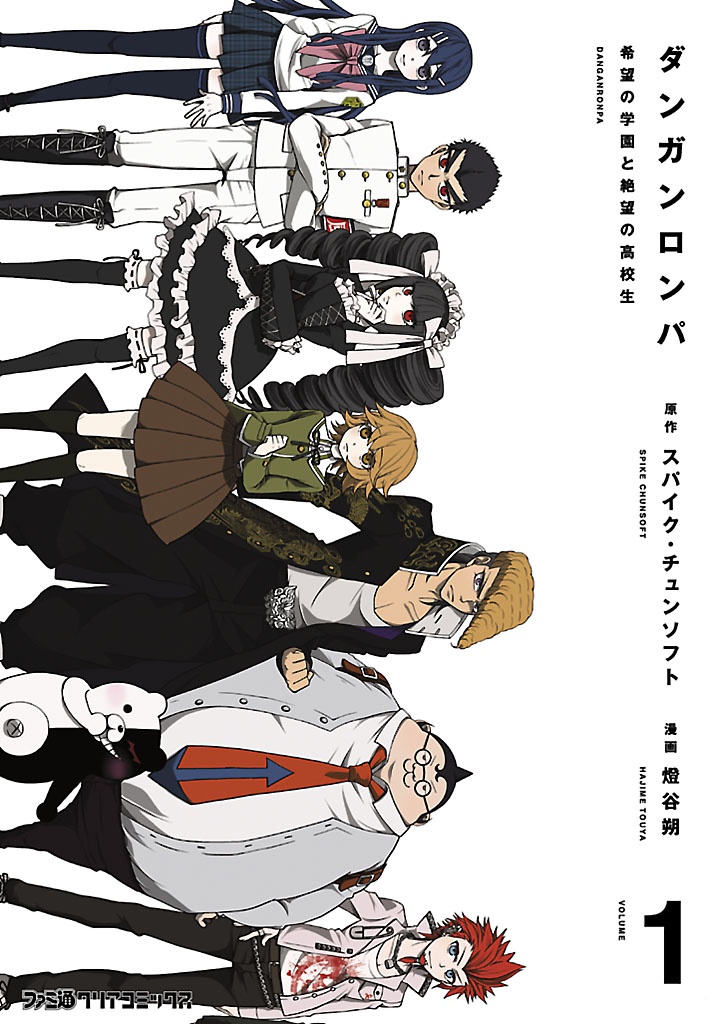
|
Danganronpa: Kibō no Gakuen to Zetsubō no
Kōkōsei A manga adaptation of Danganronpa: Trigger Happy Havoc serialized in Japan in Famitsu Comic Clear between June 2011 - October 2013, and later released in 4 volumes by Enterbrain. |

|
Danganronpa: Kibō no Gakuen to Zetsubō no
Kōkōsei 4koma KINGS 4 volumes of comedic yonkoma comics based on Danganronpa: Trigger Happy Havoc published by DNA Media Comics from July 25, 2011 - April 24, 2014. |

|
Danganronpa: Kibō no Gakuen to Zetsubō no
Kōkōsei Comic Anthology 4 volumes of short story manga based on Danganronpa: Trigger Happy Havoc contributed by many different artists and published by DNA Media from August 25, 2011 - May 24, 2014. |

|
Danganronpa:
The Animation A manga adaptation of the anime Danganronpa: The Animation, which was itself an adaptation of Danganronpa: Trigger Happy Havoc. Serialized in Japan in Shonen Ace between July 2013 - July 2014, and later released in 4 volumes by Kodokawa Comics. This manga has been released in English by Dark Horse. The manga has also been released in German, Chinese, and Spanish. |

|
Danganronpa: Kibō no Gakuen to Zetsubō no
Kōkōsei The Animation Dengeki Comic
Anthology A second anthology manga - unrelated to the previous anthologies - published by Dengeki Comics on August 27, 2013, and based on Danganronpa: The Animation. Again features a variety of different artists contributing short stories based on the Danganronpa: Trigger Happy Havoc universe. |
Stageplays
Danganronpa: Trigger Happy Havoc has been adapted into a stage play in Japan by theatre production company Cornflakes. There have been two separate productions of this play, once in 2014 and again in 2016.

|
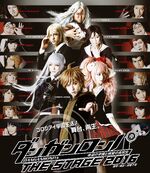
|
|
Danganronpa: THE STAGE 2014 |
Danganronpa: THE STAGE 2016 |
Sequel
A sequel titled Danganronpa 2: Goodbye Despair was released in 2012 by Spike for the PlayStation Portable. Danganronpa 2 features more variety of gameplay in both the main story and additional content to its predecessor. A bundle titled Danganronpa 1.2 Reload which features the first two games was released on 2013 for the PlayStation Vita.
Trivia
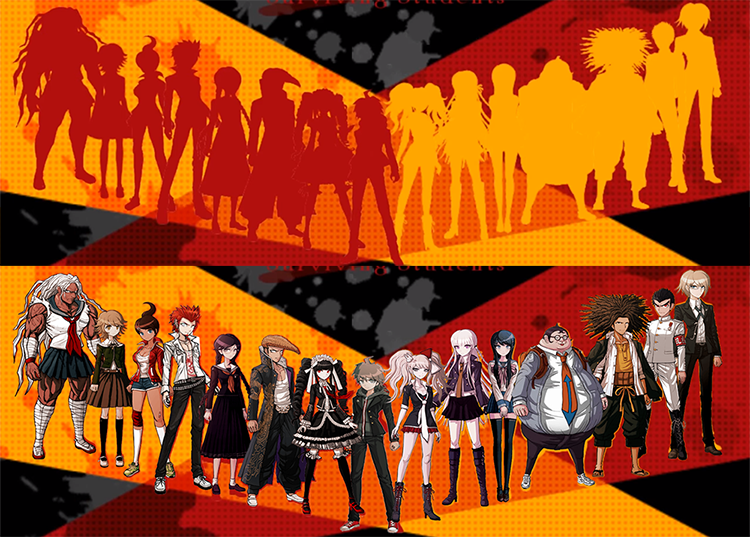
- The series' title, Danganronpa, is compounded from the words "bullet" (弾丸 dangan) and "refutation" (論破 ronpa).
- As a game defined in part by its bold aesthetics, Danganronpa was originally supposed to have a monochrome colour palette of purely black and white, but with the original pink blood which was later decided to be starkly red-coloured blood to make instances of death stick out, similar to the hyper-violent Sega game MadWorld. Even after the colour scheme was reworked to be more conventional, the blood was stylistically coloured back to bright pink to create the same visual effect.
- On the "To Be Continued" screen between chapters, the silhouettes are early beta designs of each character. Although these images are otherwise never seen in-game, they can still be found using data mining tools, as they were used as placeholders during development and can be seen in some in-development screenshots. Some of these images are visible in the character profiles which can be unlocked in the gallery.
Links
- Danganronpa.com: Danganronpa Official Site (Japanese)
- NIS America: Danganronpa: Trigger Happy Havoc sub-page (English)
- Steam: Danganronpa: Trigger Happy Havoc store listing on Steam
- iOS: Danganronpa: Trigger Happy Havoc AppStore (English)
- Android: Danganronpa: Trigger Happy Havoc Google Play Store (English)